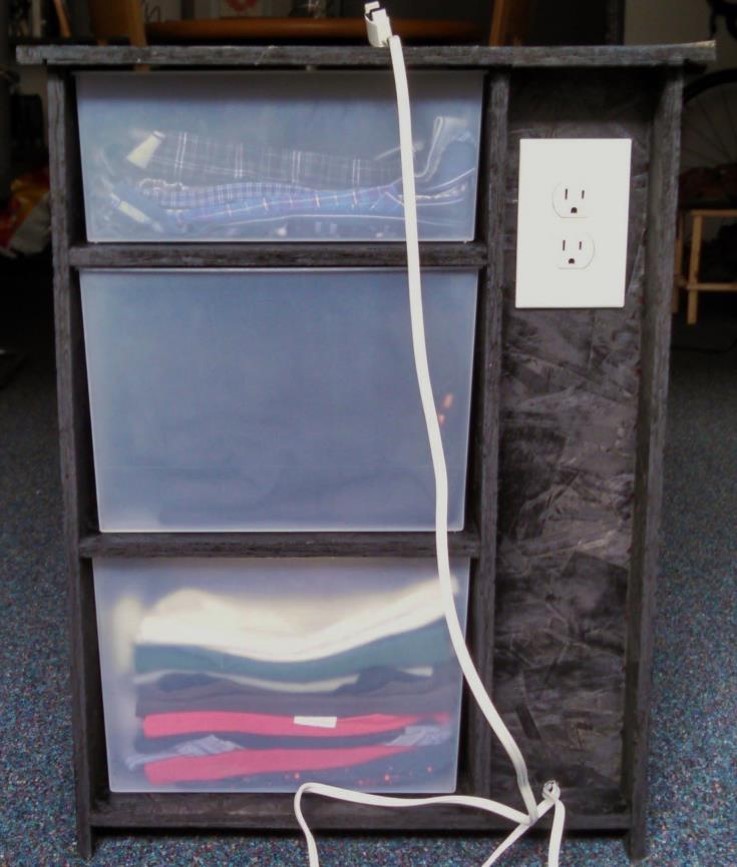
Background
Before, I was using a plastic Sterilite organizer as my bedside table
which didn't work too well. The top would always come off and it
sagged so everything fell toward the center. It looked pretty
terrible too, as you can see from the picture.
So I decided to make a table that was stronger and that looked a
little better too. I wanted to use the old drawers since they seemed
to work pretty well.

Modeling
I used SolidWorks to create a 2D sketch of all the parts.
I used the OSB but unfortunately I didn't measure the thickness
beforehand and I used 7/16 inch (0.4375 inch) which turned out to be too
small.
To hold all the pieces together I used 2 inch tabs sparated by 2
inch gaps with 0.125-inch-radius "dogbones". This worked great for
my design. For the top piece I cut a pocket down to about half the
thickness of the material which worked well except for a few minor
issues that I'll explain later.
Milling

Milling was pretty straightforward but I made a lot of little
mistakes. Going back to the pocket cut that I was talking about
before. I made two small but annoying mistakes.
First, I used a compression bit to mill out the pocket which
required a cut depth of about 0.25 inches; however, the compression
bit only works on cut depths larger than about 0.375 inches. As a
result, my pocket ended up with a really gnarled edge.
Secondly, my pockets shared an edge with the outer edge of the piece.
It's not really obvious but since we set different tool paths for
the pocket and the outer edge then the pocket needed the dogbone
shape even where the mill was going to already cutout the part
completely. I didn't realize this so I had to chisel out the
remaining fillet by hand.
Finally, I didn't accomodate for small pieces moving during milling
which I should have because the two smallest parts in my design
popped out and got pretty mangled.
Also, like I said before, the thickness of the OSB was thicker than
I had anticipated so nothing fit properly at first. Then Chris
Dewart from the Architecture Wood Shop helped me cut off about 5
mills from all my tabs to allow the pieces to fit.
-
Front

-
Back

The Finishing Touches

 Finally, I added the drawers from the old Sterilite organizer and
painted the table black. Then I wrapped some paper in front of the
Christmas lights to give it a diffuse glow. I just used paper to show
the effect but eventually I plan on finding a better material.
Finally, I added the drawers from the old Sterilite organizer and
painted the table black. Then I wrapped some paper in front of the
Christmas lights to give it a diffuse glow. I just used paper to show
the effect but eventually I plan on finding a better material.
The finished product looks better than I expected and the
light works great! The drawers fit perfectly and now I have an outlet
that's easier to reach.
Mistakes I Made
The biggest mistake I made was not measuring the OSB before milling
the parts. It made a bunch of little problems after the parts were
milled. It wasn't a huge issue but it did add some hassle. All the
other mistakes I made were explained before and weren't that big
of issues.
A small mistake I made that I never mentioned before was that I
made the dogbone radii a little too big. This forced the machine to do
multiple passes to remove the exess material. It doesn't seem like
much but it doubled the milling time for all my parts. If I were to
do it over again I would have made the diameters equal to the tool
diameter.




 Finally, I added the drawers from the old Sterilite organizer and
painted the table black. Then I wrapped some paper in front of the
Christmas lights to give it a diffuse glow. I just used paper to show
the effect but eventually I plan on finding a better material.
Finally, I added the drawers from the old Sterilite organizer and
painted the table black. Then I wrapped some paper in front of the
Christmas lights to give it a diffuse glow. I just used paper to show
the effect but eventually I plan on finding a better material.